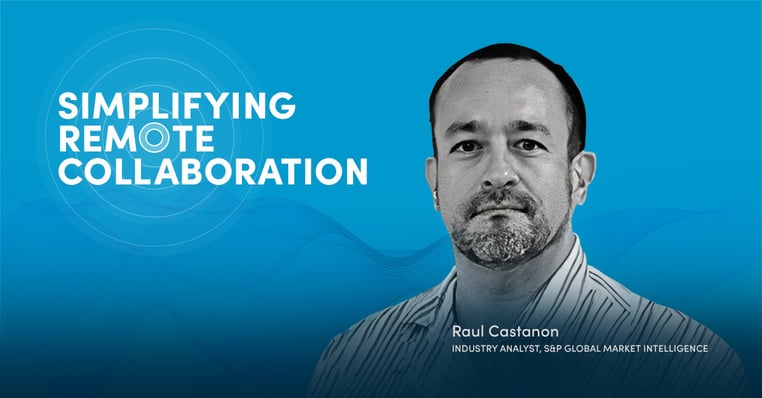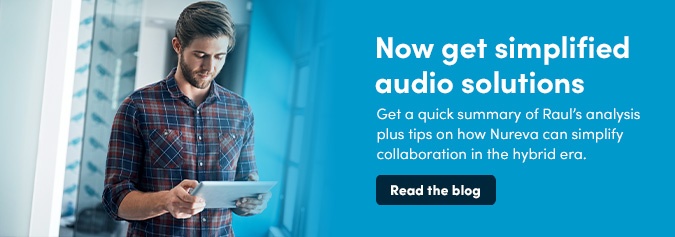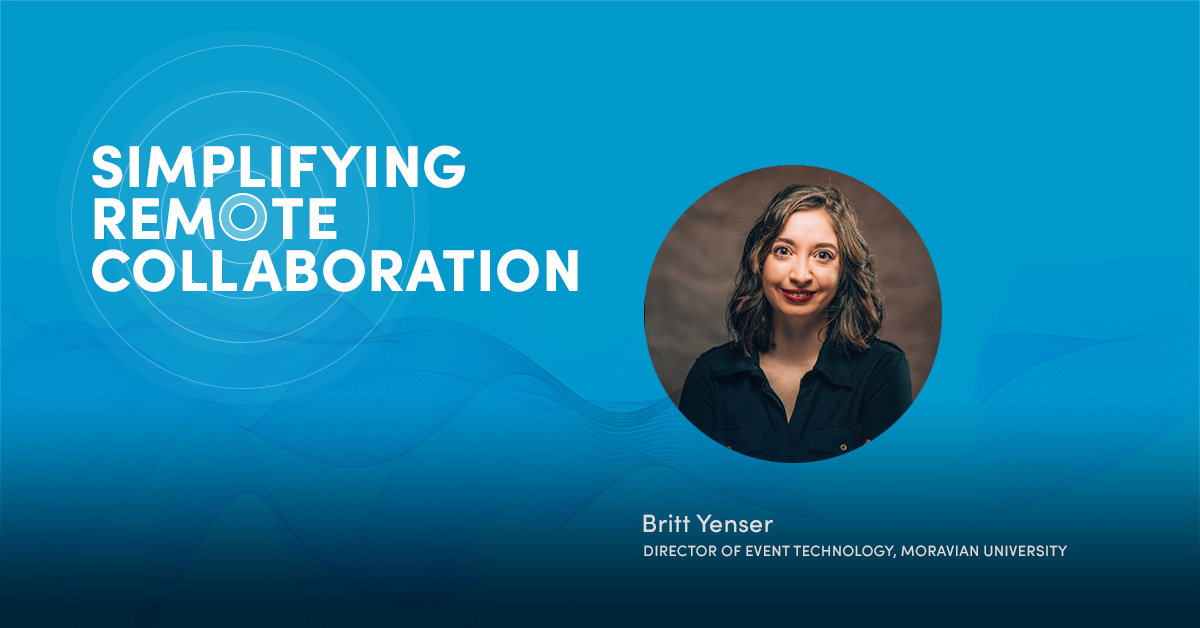Home / All posts / Collaboration
Mar 22, 2023 6:15:00 AM
Video podcast: S&P tech expert talks IT in the hybrid era

Posted by Dave McKean
The COVID-19 pandemic and the rise of hybrid work and HyFlex learning have fundamentally changed what it means to work in IT. In this episode of the Simplifying Remote Collaboration podcast, Ben Thomas talks to Raul Castanon of S&P Global. Raul tells us how IT’s role and responsibilities have evolved in a post-pandemic world to the current state of hybrid work.
Time stamps
0:00 – Series introduction
0:27 – Episode introduction
3:17 – Security and compliance
5:17 – Scalability and flexibility
7:24 – Investing in business communications and collaboration
9:43 – Doing more with less
13:09 – The need for higher quality sound and video
Podcast transcription
Series introduction: Welcome to Simplifying Remote Collaboration. In each episode, we’ll discuss how the shift to hybrid working and learning has put growing pressure on IT departments to better support remote collaboration at a time when resources are stretched thin by competing priorities. We’ll explore ways to simplify the IT setup and management of hybrid spaces.
Ben: Hey everyone, and welcome back to Simplifying Remote Collaboration. I am your host for today, Ben Thomas.
You know, when you look back at the pandemic, and even in the post-pandemic world, some of the people who have been impacted the most, by changing workforce infrastructures and the constant shifts in technology and demands, have been our IT and technology teams.
In some cases, it’s even to the point where it has almost totally changed their job description. Now they’re having to make decisions on pieces of gear, remote technology and really helping to decentralize workforces to collaborate in a way that they never were able to before. And now that we have enough data – especially over a two-to-three-year term – it's time for us to analyze and dig in a little bit deeper into what that means for our community.
And to help break it down for us today, I’ve got Raul Castanon from S&P Global. Raul, thanks so much for coming on the show.
Raul: Thank you for having me.
Ben: Well, Raul, one of the things that you’ve seen at S&P is that data helps support some of those metrics. So set the table for us a little bit. What are some of the data points that you’re seeing for the IT and integrated technology world?
Raul: Definitely a good starting point. What we have seen is basically an evolution in three distinct phases. First, we have the office-centric work environment with occasional mobile and remote workers. Then, from one day to the other, we were all forced to work remotely. That’s a very distinct second phase – with many challenges for IT. What we’re seeing now, from the survey that we did in October, is that most companies are now transitioning to a third distinct phase where it’s all about hybrid work. It’s the buzzword of the year, for sure. But it’s definitely a trend that is impacting how we conduct ourselves in our day-to-day work. So, the first thing that I will highlight, Ben, is that it’s a separate, distinct phase. And it has different challenges from the ones that we experienced at the beginning of the pandemic, where the focus was more on business continuity. Now it’s all about flexibility.
Ben: We talk about the changing roles and challenges for IT and technology teams at enterprise places. Break it down a little bit more for us. What are some of the core challenges that you’re seeing these people face on a day-to-day basis?
Raul: Security and compliance certainly are key to this transition into a new phase. When you go from the office-centric environment where IT basically had near full control of the environment to a remote work environment, that really changes the landscape in terms of security. Since the focus at the start of the pandemic was more on business continuity, we know that many organizations actually bypassed security and compliance, or they were forced to be more flexible.
Now that it is nearly three years after the start of the pandemic, what we see is organizations paying more attention to security and compliance. And it’s not just the need to support the distributed environment (since we know that many people will choose to remain working remotely) but you also have external factors. Last year, I think it was around September, the SEC came down on financial firms and banks regarding compliance and security for business communications. IT is now facing increased pressure to enforce security and compliance. That's going to be a big topic this year.
Ben: You know, the actual purchasing decisions, the way that people are making decisions on gear, whether it be webcams, whether it be things like laptops or even collaboration technologies, has evolved. And that buying cycle looks a little bit different. Talk about how the data supports some of those changes in the buying cycle.
Raul: Well, you bring up two topics that I think are central to what we’re seeing right now in terms of challenges for IT. In addition to security and compliance, you have scalability and flexibility. What IT needs to do now – going from the office-centric to the extreme distributed workforce – is a combination that requires flexibility. And that flexibility significantly increases the level of complexity that IT has to deal with. We now have to deal with the uncertainty of how many people will be participating in a meeting. Will they be present in the office or remote? Can we provide the same level of experience to both those that are in the office and those that are participating remotely? That brings on numerous challenges. In addition to that, rather than a centralized workforce in an office you have a multitude of endpoints to take care of. So, how will you do that at a scale? That definitely brings up numerous challenges, including, for example, the need for automation and the ability of IT to do many tasks remotely as well.
Ben: When we talk about some of these implementation challenges, things like having to support new devices and support new users and support onboarding, what are some of the key challenges that this new technology and some of these new responsibilities are creating from an actual device management and IT standpoint?
Raul: Great question. Getting back to the context of going from office-centric to remote work and now to a mixed environment, there was significant investment in communications and collaboration at the beginning of the pandemic – namely, because of the need for business continuity. That was the urgency we saw at the start of the pandemic. Going back to Q2 and Q3 2020, there was a significant contraction in terms of IT spending. Out of the 10 categories that we follow, the only one that did not experience a contraction was business communications and collaboration. And that trend has continued through the lockdown period until now.
We still see companies investing there. Now, last year there was a shift because companies were coming out of the pandemic. They were investing, for example, in remote work technologies. So you see a lot of companies investing in mobile phones, laptops, tablets – all sorts of devices – as well as business communications and collaboration software, cameras and other peripherals.
However, towards Q3 and Q4 with all the macroeconomic factors – including the war in Ukraine, inflation concerns, interest rates and companies going into layoff mode – we see once again a contraction in spending. What’s interesting this time is that there are still requirements that need to be addressed and that IT has to deal with.
What we are seeing is more careful assessment of how they will be spending their money. In other words, they want to do more with less. I think that’s a stronger testament to the trend that we see with unified communications. So rather than having different, separate tools, in many cases they may be actually duplicating technologies. Companies are looking to optimize and streamline the tools they have. This means a contraction in spending. But I think what companies are doing is just being very careful how they spend their money.
Ben: You know, when you look at these off-site teams, whether they be hybrid, whether they be decentralized teams altogether, one of the biggest challenges has been to create a scalable environment. And you see, specifically with a lot of the hybrid workforce, that some people are in office sometimes and not others. And there’s kind of this weird push and pull of numbers of people that are in offices. But now we have to create technology and environments – whether that be in conference rooms and control rooms or leveraging meeting technology – and make them adaptable to whatever needs you might have that day. Talk about some of the ways that you’re seeing the IT teams deal with some of that.
Raul: Yes, there are a lot of interesting changes here. One interesting trend we saw last year was that even as the lockdown conditions were phased out we didn’t see many employees going back to their daily commute. So looking at different statistics, the number seems to have plateaued at about 50% in terms of how many employees are actually going back to the office, with the remaining either staying at home or having a hybrid work schedule.
What does that mean for the office? Well, we also saw that a significant number of organizations are downsizing their corporate offices. Obviously there is a lot of unoccupied office space. However, while at first there were concerns in terms of what this means for AV specialists, we did see, last year, significant investment in renovating office spaces. We saw many companies getting rid of cubicles and individual offices. Instead, they’re investing in more collaborative environments. Meeting rooms, for example, are being updated with the latest technology that supports hybrid work – in other words, providing an equally engaging experience for those that are in the office as well as for those that are working remotely.
There are still many opportunities for AV specialists. They come with some new nuances though. They require more attention to advanced technologies. There is definitely a need for higher quality sound and video, both for the in-person participants, but also for the remote participants. And the last thing that I could say is that with so many people working in different places, it puts more demands on IT. Not just in terms of providing a good level of experience for those remote users, but also the ongoing support that this requires. It's a challenge for IT and for AV specialists, for sure.
Ben: I appreciate that answer, Raul. It’s helpful to hear that context. One of the things that I wanted to ask specifically revolves around what I’ll call the typical channel. Historically, the IT and technology decision-making process looks a little bit different. And today you’re seeing a lot more of these decision makers work with designers, work with integrators, work even in some cases directly with hardware companies. How would you say the specing and even that buying process has evolved in the last couple of years?
Raul: The shift to this new work environment accelerated trends that your listeners may have already seen as common before the pandemic. But they have really accelerated requiring AV specialists to stay up to date, for example, in terms of their system’s capabilities for automation and reducing the need to do on-site support. They have had to centralize support as much as possible. That translates into cloud-based capabilities, for example, for monitoring AV equipment. And they need to think about the need for IT to scale their capacity to support different sites at the same time – and probably with a smaller number of people.
The other interesting dimension to this is that there are many employees that have come on board that are remote, and they don’t know what it’s like to go into the office every day. So what does this mean for IT? It means you have to provide an onboarding, day-one capacity to help these employees be productive from the very start. And then there is ongoing provisioning and support – you know, the full cycle that AV technology requires.
All of that has to be scalable. It has to be, as you said, easily deployed and in a very fast way. You cannot afford to have someone sitting at their home for one or two weeks waiting for their laptop to come in and then set it up, and so on.
Ben: Raul, we appreciate your insight, and we appreciate all of the information that you’ve given our listeners today. Raul Castanon over at S&P Global, thanks so much for joining us on Simplifying Remote Collaboration. And thank you all for listening. We hope to have you tune in again soon.

Posted by
Dave McKean



















